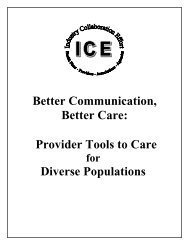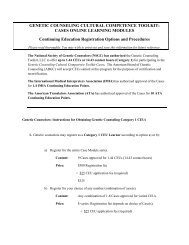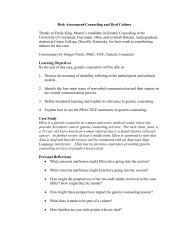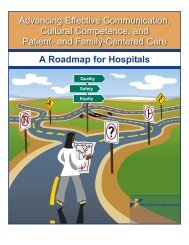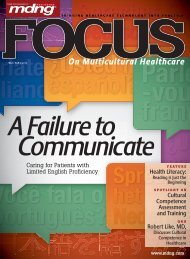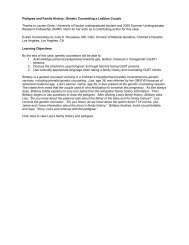making the business case for culturally and linguistically appropriate ...
making the business case for culturally and linguistically appropriate ...
making the business case for culturally and linguistically appropriate ...
Create successful ePaper yourself
Turn your PDF publications into a flip-book with our unique Google optimized e-Paper software.
• Technology: A dedicated web site <strong>for</strong> HCICP (www.kphci.org) was developed <strong>and</strong>continues to be maintained.The success of <strong>the</strong> HCICP over <strong>the</strong> years <strong>and</strong> its ongoing expansion to 15 additionalgeographic areas has shown that partnerships between health care organizations <strong>and</strong>accredited academic institutions are sustainable <strong>and</strong> mutually beneficial. Collaborative ef<strong>for</strong>tsmeet a mutual need by joining <strong>the</strong> health institutions in need of professional HCI <strong>and</strong> <strong>the</strong>academic institutions that train <strong>the</strong>m. Kaiser Permanente encourages <strong>and</strong> implementsongoing HCICP partnerships outside its service area.BENEFITS/RESULTS.• Established six internship programs at Kaiser Permanente facilities <strong>and</strong> hospitals.• Partnered with Hablamos Juntos, a project of <strong>the</strong> Robert Wood Johnson Foundation,to establish 10 additional program sites throughout <strong>the</strong> country.• Trained <strong>and</strong> certified more than 100 college-level instructors <strong>and</strong> staff at KaiserPermanente’s HCI Instructor Institute.• Graduated more than 900 students from HCICP at partnering colleges with a 90percent successful completion rate.• Enhanced HCICP students’ marketability <strong>and</strong> readiness <strong>for</strong> employment in healthcare while building community capacity to serve limited English populations.Graduates represent <strong>the</strong> following languages <strong>and</strong> dialects: Arabic, Cantonese, Farsi,Japanese, Khmer, Korean, Laotian, M<strong>and</strong>arin, Portuguese, Russian, Spanish, Tagalog<strong>and</strong> Vietnamese.• Increased internal Kaiser Permanente work<strong>for</strong>ce capacity by improving HCI skillsamong employed staff.• Based on a Kaiser Permanente-funded research study, providers who used trainedHCI overwhelmingly preferred <strong>the</strong>m over untrained HCI (family members <strong>and</strong>bilingual staff). The same study found that patients were able to differentiate betweentrained <strong>and</strong> untrained HCI, <strong>and</strong> favor trained HCI significantly.In addition, <strong>the</strong> HCICP graduates fulfill cultural <strong>and</strong> linguistic health service needs,contribute to Kaiser Permanente’s overarching mission to reduce health disparities <strong>and</strong> aid incompliance with federal <strong>and</strong> state m<strong>and</strong>ates such as Title VI of <strong>the</strong> Civil Rights Act of 1964.The HCICP project received <strong>the</strong> NCQA Recognizing Innovation in Multicultural HealthCare Award in 2006 <strong>and</strong> <strong>the</strong> AHIP Community Leadership Award in 2007.LESSONS LEARNED/NEXT STEPS. Surveys are used to continually evaluate <strong>the</strong>program, monitor employment rates of graduating students, <strong>and</strong> identify areas <strong>for</strong>improvements. Program evaluations are also being developed to examine patient careprocesses <strong>and</strong> outcomes. In addition, language assessments will be developed to better servenew students, <strong>and</strong> processes <strong>for</strong> internship <strong>and</strong> career placement programs will be fur<strong>the</strong>rrefined.Lessons learned include recognition of a spectrum of HCI competencies that should beaddressed by providing different levels of trainings. Additionally, <strong>the</strong> HCICP curriculum isupdated continuously to reflect changes in heath care <strong>and</strong> <strong>the</strong> demographic shifts that mayimpact <strong>the</strong> populations served in specific service areas.40



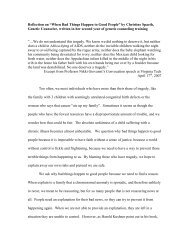
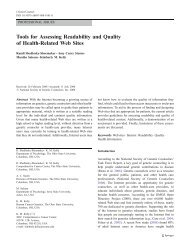

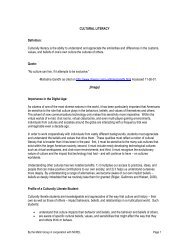
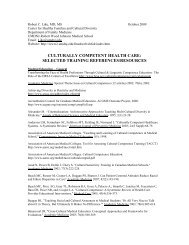

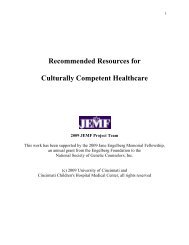
![Breaking Bad News PPT[1] - Genetic Counseling Cultural ...](https://img.yumpu.com/35003134/1/190x146/breaking-bad-news-ppt1-genetic-counseling-cultural-.jpg?quality=85)
